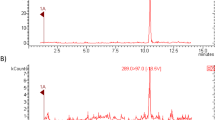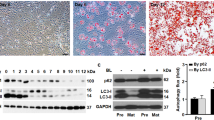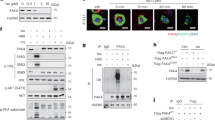Abstract
Objective:
In the adipose tissue, activation of AMP-activated protein kinase (AMPK) by phosphorylation favours local fatty acid oxidation and inhibition of lipogenesis. We have previously shown that the potent androgen dihydrotestosterone (DHT) can inhibit phosphorylation of AMPK in adipose tissue and 3T3-L1 adipocytes in a dose-dependent manner. This negative effect of DHT was reversed by oestrogen treatment. The purpose of this current study was to determine the underlying mechanisms whereby androgens and oestrogens can regulate AMPK phosphorylation in adipocytes, and whether this mechanism is receptor dependent.
Results:
Phosphorylation of AMPK was assessed by western blot in cells treated for 24 h with testosterone or DHT (1–1000 nM). Testosterone and DHT significantly inhibited basal phosphorylation of AMPK. Addition of the androgen receptor antagonist Flutamide (1 μM) to the media reversed the negative effect of testosterone and DHT by returning AMPK phosphorylation levels to those of basal. To further dissect the mechanism underlying AMPK inhibition by testosterone or DHT, we examined the mRNA expression of the upstream activator of AMPK, namely LKB1. Testosterone and DHT treatment of murine 3T3-L1 or human SGBS adipocytes for 24 h significantly decreased the mRNA expression of LKB1. In contrast, 17β-estradiol treatment increased LKB1 mRNA, an effect mediated by oestrogen receptor alpha.
Conclusion:
We conclude that regulation of AMPK phosphorylation by androgens and oestrogens is receptor-dependent, and demonstrate for the first time that LKB1 is regulated by sex hormones in adipocytes.
This is a preview of subscription content, access via your institution
Access options
Subscribe to this journal
Receive 12 print issues and online access
$259.00 per year
only $21.58 per issue
Buy this article
- Purchase on Springer Link
- Instant access to full article PDF
Prices may be subject to local taxes which are calculated during checkout



Similar content being viewed by others
References
Poehlman ET . Transversing the menopause: change in energy expenditure and body composition. Coron Artery Dis 2005; 16: 511.
Liu YM, Ding JZ, Trudy TL, Longenecker JC, Nieto FJ, Golden SH et al. Relative androgen excess and increased cardiovascular risk after menopause: a hypothesized relation. Am J Epidemiol 2001; 154: 489–494.
McInnes KJ, Corbould A, Simpson ER, Jones ME . Regulation of adenosine 5′,monophosphate-activated protein kinase and lipogenesis by androgens contributes to visceral obesity in an estrogen-deficient state. Endocrinol 2006; 147: 5907–5913.
Fisher CR, Graves KH, Parlow AF, Simpson ER . Characterization of mice deficient in aromatase (ArKO) because of targeted disruption of the cyp19 gene. Proc Natl Acad Sci USA 1998; 95: 6965–6970.
Simpson ER, Misso M, Hewitt KN, Hill RA, Boon WC, Jones ME et al. Estrogen—the good, the bad, and the unexpected. Endocr Rev 2005; 26: 322–330.
Jones MEE, Boon WC, McInnes K, Maffei L, Carani C, Simpson ER . Recognizing rare disorders: aromatase deficiency. Nat Clin Pract Endocrinol Metab 2007; 3: 414–421.
Woods A, Johnstone SR, Dickerson K, Leiper FC, Fryer LGD, Neumann D et al. LKB1 is the upstream kinase in the AMP-activated protein kinase cascade. Curr Biol 2003; 13: 2004–2008.
Brown KA, McInnes KJ, Hunger NI, Oakhill JS, Steinberg GR, Simpson ER . Subcellular localization of cyclic AMP-responsive element binding protein-regulated transcription coactivator 2 provides a link between obesity and breast cancer in postmenopausal women. Cancer Res 2009; 69: 5392–5399.
Barros RPA, Gabbi C, Morani A, Warner M, Gustafsson JA . Participation of ER alpha and ER beta in glucose homeostasis in skeletal muscle and white adipose tissue. Am J Physiol-Endocrinol Metabol 2009; 297: E124–E133.
Yu IC, Lin HY, Liu NC, Wang RS, Sparks JD, Yeh S et al. Hyperleptinemia without obesity in male mice lacking androgen receptor in adipose tissue. Endocrinol 2008; 149: 2361–2368.
Pasquali R . Obesity and androgens: facts and perspectives. Fertil Steril 2006; 85: 1319–1340.
Alessi DR, Sakamoto K, Bayascas JR . LKB1-dependent signaling pathways. Annu Rev Biochem 2006; 75: 137–163.
Carling D . LKB1: a sweet side to Peutz-Jeghers syndrome? Trends Mol Med 2006; 12: 144–147.
Acknowledgements
This work was supported by the Victorian Breast Cancer Research Consortium Inc., NHMRC Project Grant No. 494819 and Program Grant No. 494802. KJM supported by an RD Lawrence Personal Fellowship from Diabetes UK. KAB is supported by an NHMRC Career Development Award. ERS is supported by an NHMRC Senior Principal Research Fellowship.
Author information
Authors and Affiliations
Corresponding author
Ethics declarations
Competing interests
The authors declare no conflict of interest.
Rights and permissions
About this article
Cite this article
McInnes, K., Brown, K., Hunger, N. et al. Regulation of LKB1 expression by sex hormones in adipocytes. Int J Obes 36, 982–985 (2012). https://doi.org/10.1038/ijo.2011.172
Received:
Accepted:
Published:
Issue Date:
DOI: https://doi.org/10.1038/ijo.2011.172
Keywords
This article is cited by
-
CXXC5 as an unmethylated CpG dinucleotide binding protein contributes to estrogen-mediated cellular proliferation
Scientific Reports (2020)
-
Gonadectomy in Mito-Ob mice revealed a sex-dimorphic relationship between prohibitin and sex steroids in adipose tissue biology and glucose homeostasis
Biology of Sex Differences (2018)
-
A spatiotemporal hypothesis for the regulation, role, and targeting of AMPK in prostate cancer
Nature Reviews Urology (2017)
-
Testosterone stimulates glucose uptake and GLUT4 translocation through LKB1/AMPK signaling in 3T3-L1 adipocytes
Endocrine (2016)
-
Hyperinsulinaemic androgen excess in adolescent girls
Nature Reviews Endocrinology (2014)



